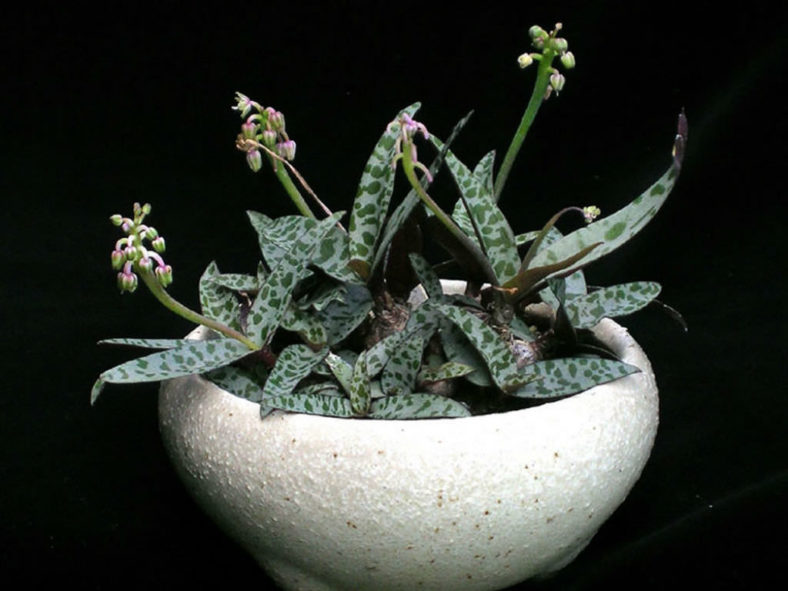Ledebouria socialis, commonly known as Silver Squill, is a geophytic species of bulbous perennial plant native to the Eastern Cape Province of South Africa. It grows in arid savanna in summer-rainfall regions where it is found in fine to medium-grained, shallow to deep, well-drained, humus-rich soil. It usually grows in the shade, mostly in closed evergreen woodland. The plant makes an attractive, colorful, and structurally unique houseplant.
Silver Squill has teardrop-shaped bulbs that form above the ground. They look like tiny purple bladders and can store moisture during drought. The leaves arise from these structures. They are lance-shaped and silver spotted with purple undersides. In summer, the pink stems form, bearing small greenish flowers. The entire plant only gets up to 10 inches (30 cm) tall, with a rosette formed from foliage out of the bulbs. Succulent growers favor it, but it is not a succulent plant, although it resembles one and has the drought tolerance of the group.
Growing Conditions and General Care
Silver Squill is often cultivated as a houseplant and grows with minimal care. However, it requires bright light, with 3 to 4 hours of direct sunlight per day.

The interior temperatures are fine during the active growth period for Silver Squill grown as houseplants. Outdoor plants can withstand winter temperatures down to 30°F (-1°C). Try growing Silver Squill outdoors during spring and summer when ambient temperatures are at least 60°F (15°C). In cold regions, move the plant back indoors.
Use a soil-based potting mixture and plant Silver Squill bulbs in pans or half-pots. Pot up the bulbs in the spring, but no more than three in a single 4 to 6 inches (10 to 15 cm) pot. Space the bulbs evenly over the surface and bury only the bottom half of each bulb in the potting mixture. During the first 4 or 6 weeks, do not feed the plants and water sparingly, allowing the top half of the potting mix to dry out between waterings. Treat the plants as usual when the new roots are well established. Break up overcrowded clumps every 2 or 3 years.
Once established, water needs are minimal. Allow the top inch (2.5 cm) to dry out before irrigating in spring and summer. Once winter has arrived, the plant is in its rest phase (dormancy), and watering should be cut in half.
During the growth season, apply liquid fertilizer once per month.
Propagation
Growing Silver Squill is extremely easy. The bulbs will increase over the years until the plant is crowded in its pot. The next time you repot it, you can separate some bulbs to start new plants. Wait until the flowers have faded, unpot the plant, and gently break away the bulbs.
While Silver Squill propagation is possible through seed, germination can be capricious, and the growth is very slow.
Source: gardeningknowhow.com
Links
- Back to genus Ledebouria
- Succupedia: Browse succulents by Scientific Name, Common Name, Genus, Family, USDA Hardiness Zone, Origin, or cacti by Genus